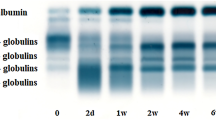Abstract
SWAYBACK is a disease of lambs in which lesions in the white matter of the spinal cord are associated with low levels of copper in the tissues. Mills and Fell1 reported the experimental production of swayback using a high molybdenum, high sulphate diet. Their results indicated that this diet strongly inhibited the transfer of copper from the ewe to the lamb. Any preparation which facilitates the investigation of demyelination associated with reduced copper-levels in a laboratory animal would be of great value. Můr, Záruba and Charamza2 reported a destruction of myelin in rabbits following the repeated intravenous administration of a solution of either α-benzoin-oxime or of diethyldithiocarbamate. The administration of α-benzoin-oxime resulted in a decrease in the blood copper-level in nine out of twelve animals. The effect of diethyldithiocarbamate on the blood copper-level was determined in two rabbits and resulted in a decrease in both. Changes in myelin, particularly in the spinal cord, were recorded after diethyldithiocarbamate had been administered for only three weeks. For these reasons the effect of sodium diethyldithiocarbamate in the rabbit has been further investigated, but it has not been possible, as yet, to confirm the effect on myelin. However, in the course of the work it became clear that sodium diethyldithiocarbamate interfered with the blood copper-level and had a marked effect on pregnancy.
This is a preview of subscription content, access via your institution
Access options
Subscribe to this journal
Receive 51 print issues and online access
$199.00 per year
only $3.90 per issue
Buy this article
- Purchase on Springer Link
- Instant access to full article PDF
Prices may be subject to local taxes which are calculated during checkout
Similar content being viewed by others
References
Mills, C. F., and Fell, B. F., Nature, 185, 20 (1960).
Mur, J., Záruba, M., and Charamza, O., Acta Universitatis Palackianae Olomucensis, 11, 141 (1956).
Eden, A., and Green, H. H., Biochem. J., 34, 1202 (1940).
Dutt, B., and Mills, C. F., J. Comp. Path., 70, 120 (1960).
Mohnike, G., Hagemann, U., and Glöckner, E., Z. ges. exp. Med., 128, 115 (1956).
Du Bois, K. P., Raymund, A. B., and Hietbrink, B. E., Toxicol. App. Pharmacol., 3, 236 (1961).
Keilin, D., and Hartree, E. F., Proc. Roy. Soc., B, 129, 277 (1940).
Yamada, H., and Yasunobu, K. T., J. Biol. Chem., 237, 3077 (1962).
Author information
Authors and Affiliations
Rights and permissions
About this article
Cite this article
HOWELL, J. Effect of Sodium Diethyldithiocarbamate on Blood Copper-levels and Pregnancy in the Rabbit. Nature 201, 83–84 (1964). https://doi.org/10.1038/201083b0
Issue Date:
DOI: https://doi.org/10.1038/201083b0
This article is cited by
-
Further observations on the response of the peripheral and central nervous system of the rabbit to sodium diethyldithiocarbamate
Acta Neuropathologica (1973)
-
Changes in the central nervous system of lambs following the administration of sodium diethyldithiocarbamate
Acta Neuropathologica (1970)
-
Changes in the Nervous System of Rabbits following the Administration of Sodium Diethyldithiocarbamate
Nature (1966)
Comments
By submitting a comment you agree to abide by our Terms and Community Guidelines. If you find something abusive or that does not comply with our terms or guidelines please flag it as inappropriate.


